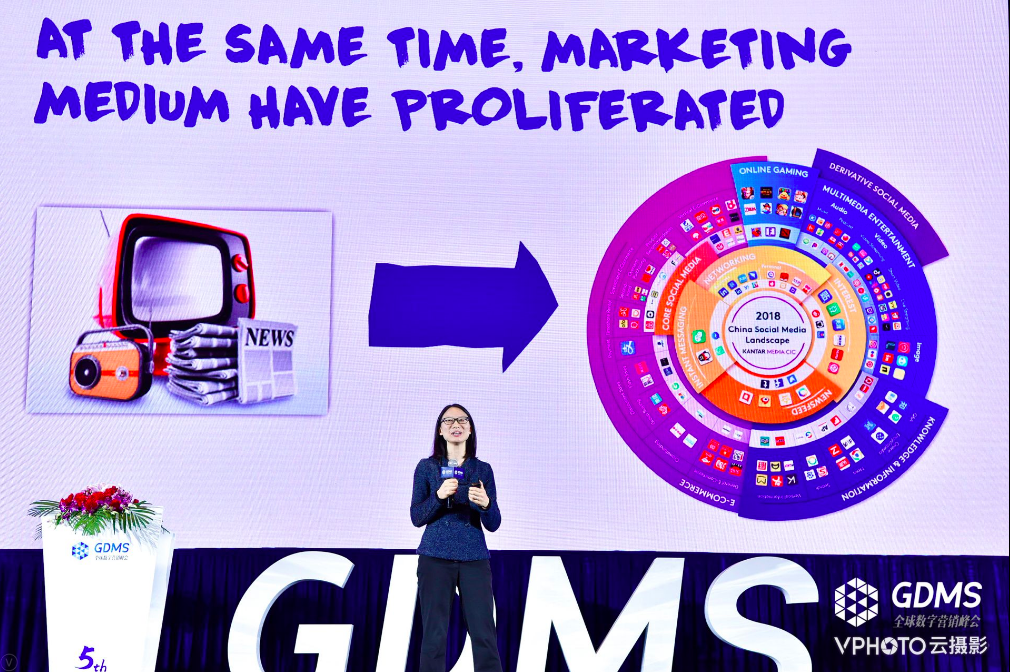The ‘big idea' has long been the traditional core of advertising and how entire campaigns are organized but it seemed to have lost its luster in the new age of socialized marketing and new consumer behaviors in China.
We were at GDMS, a 4000-strong conference held in Shanghai last week, where nobody is betting on a singular big idea anymore, or even mentioning creativity very much. In China, marketers and their agencies cannot assume that a standalone, bold, creative concept will work effectively across a fluid and fragmented social environment, where influencers and crowd-sourced UGC content cause advertising activity to be dispersed into a litany of splintered ideas.
Amy Chen, vice president and CMO for PepsiCo's snacks category in Greater China (pictured below), experienced this for herself when she relocated from North America to the mainland one and a half years ago. "This quote by Aristotle is very appropriate for marketing in China in the digital era today: 'The more you know, the more you don't know'.” Back to the early days of branding, the goal of a brand was simply to be a guarantor of functional quality and it was "all about reaching into people's heads", Chen said. When product quality improved across the board, the job of marketers became much harder, she added.

Furthermore, the phenomenon of "self-centered information cocoons" in China is serious, according to Zhang Rui, the founder and CEO of Social Touch, and is increasingly marginalizing the big idea.
"Today, due to the fragmentation of media and clustering of communities, we found that each Chinese consumer lives in his/her own information cocoon. They can work in the same office or live in the same compound but find that the other person has a vastly different lifestyle from him or her. There is no mainstream consumer group in China anymore, but divided into more than 100 sub-groups or 'cocoons'", Zhang said, also speaking at the conference.
In the case of the groundbreaking SK-II ad (pictured below) from the past year, its controversy stemmed not only from the variety of pressures imposed from parents and society on women who are marriageable, but among the women themselves. "We found that the viewpoints of the ad were dichotomous," said Zhang. "Some female consumers like the ad very much because it reflected the reality they were in; an equal number of them was disgusted as it actually hurt their feelings for being 'left over'."

It was simple to capture and execute a 'big idea' in the past, because the media choices in China were direct and only in the dozens. "Now, hundreds of platforms and hundreds of thousands of influencers on those platforms are communicating with different desired targets all at the same time," he said. New channels are constantly mushrooming, at risk of throwing marketers off balance.
On the Douyin and Xiaohongshu platforms, what consumers pursue are completely different. Folks hanging out on Xiaohongshu, for example, are usually seeking precise pointers on what to buy, so it is effective to do product recommendations and user evaluations, analyzed P&G haircare branding general manager Franny Lui. "Conversely, if we go to Douyin, the consumer is wanting to have fun and pass the time, so something that can make people laugh, that is for the win, said Lui.
Novelty, instead of singularity, becomes part of everyday marketing in China to millennials and centennials. These young consumers love to research on social media before they shop—they generally need eight touch points before they make a purchase, which is four more than Western shoppers—according to McKinsey China. So, KOLs and content creators in China serve this curious market by providing detailed or snappy pieces of content spread out in China’s online ecosystem.
An Accenture 2017 report stated 70 percent of Chinese Gen Z consumers — or those born after 1995 — prefer buying products directly via social media than other channels. The global average is 44 percent. Therefore, it is an irreversible trend for social commerce to be the new norm in China, though it is fraught with uncertainty for brands as the concept is born out of spontaneous play, summed Bilibili vice president Anchor Kiu.
During the summer, P&G haircare brand Aussie worked with Youku on sponsoring a variety show that reveals a celebrity's personal shopping list. "Many consumers enjoy this kind of voyeurism. What exactly is this star buying, and why?" explained Lui.
PepsiCo also affords young consumers the same sense of voyeurism. "Last year, we started a model of co-creation at PepsiCo that integrated them into our ideation process," described Chen. "With a 'board of directors' of normal youths who provide us information once per quarter what they are into culturally, we brainstormed better names for our two new flavors of Lays potato chips launched this year."
'Romantic Sakura' became 'Cutie Sakura. 'Fresh Matcha' became 'Forgiving Matcha'. "We were told that we were overthinking the original names," said Chen. PepsiCo also partnered with Douyin where hundreds of users dramatically imitated a short-video template initiated by influencer Papi Jiang who demonstrated being ‘teased’ by Lays chips (see photo above). “Apart from showcasing the brand attributes, like flavourful, thin, crispy, and irresistible, we also wanted users to have a lot of fun."
Tons of examples showcased at the conference, presented mostly in Mandarin, demonstrated the China market's deviation from embracing the 'big idea' or a consistent creative concept.
Kimberly Clark's regional sector leader for adult and feminine Care APAC, Dominic Iacono, highlighted how sanitary pad brand Kotex used Kuwo Music to produce a customized Chinese-language rap, seeding localized nicknames for the word 'period' exaggerated with GIF memes on Weibo, injecting the product into Japanese anime scenes by redrawing the entire episode broadcasting on manga platform Bilibili.

Zhihu's VP Chen Xin recalled how Audi in July used a myth-busting approach to advertise its A3, R8, R3 and RS6 models by trying to prove that steaks and lobsters can be cooked using just engine heat. Another campaign saw the Friso instant formula brand posing as a verified 'user' on the knowledge-sharing platform and asking a question ('How long should a scarf be on a giraffe should the animal wear one?') and then proceeded to print the user-generated answers, that even calculated the length, weight and material costs of the scarf, on its milk powder cans.
This state of marketing in China, though certainly fun and clickbaity, has caused the industry to be "scattered" and "chaotic", pointed out Social Touch's Zhang. "This chaos I see is the most heart-wrenching for me. Marketing clearly creates huge added value for business, but in China, it just creates confusion. I am not proud of this year's World Cup advertising by Chinese sponsors, for instance. We are actually producing very bad work and forcing memory and cognition on the part of consumers just because, World Cup."
"Dominant, but actually a very, very poor performance in branding. This has really become a big pain point in our industry."
This post by Jenny Chan originally appeared on Campaign Asia, our content partner.
